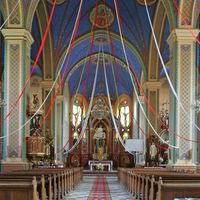Dąbrowa Białostocka
7.02

Overview
Dąbrowa Białostocka is an urban-rural municipality located in the Podlaskie Voivodeship, within the Sokółka County, with its administrative seat in Dąbrowa Białostocka. Covering an area of 263.95 km², the municipality is predominantly agricultural, with around 75% of its land being farmland, highlighting the significant role of agriculture in the local economy. It is home to the Biebrza National Park, which offers a wealth of natural beauty. As of June 30, 2008, the municipality had a population of 12,530 people. Its unique spatial layout is characterized by numerous village districts, such as Bagny, Dąbrowa Białostocka, and Nowinka, which create diverse residential and activity areas.
Among the historical monuments in the municipality is the neo-Gothic Church of St. Stanislaus, built between 1897 and 1902, adjacent to which lies a cemetery dating back to the 16th century and a small chapel from the turn of the 19th and 20th centuries. Another notable site is the wooden Orthodox Church of the Holy Myrrhbearers in Jaczno, constructed in the second half of the 19th century. The area also features a concrete windmill from 1928 and the remains of the Kalno estate, which served as the residence of the local administrator and has a rich history dating back to the interwar period of the Second Polish Republic.
The municipality also boasts significant Jewish heritage, including a Jewish cemetery from the 17th century, as well as two synagogues, a school, and a bathhouse dating from before World War II. Another point of interest is the Marian Sanctuary in Różanystok, which attracts numerous pilgrims. Dąbrowa Białostocka combines rich cultural and historical heritage with natural beauty, making it an intriguing destination for visitors interested in exploring local traditions and the history of the region.
Location
2025 Wizytor | All Rights Reserved

